[raw]<div style="max-width: 1024px; margin: auto; float: left;">[/raw]

G.R. Whale
Ram and Cummins have skipped the nickel-and-diming for the 2019 ratings war, going straight to 1,000 pound-feet and a top tow rating in excess of 35,000 pounds. There’s plenty of other stuff too, but you’re going to hear those numbers a lot.
The new 6.7-liter Cummins is built on a CGI (compacted graphite iron) block—lighter, stronger, quieter and proven. Bore and stroke are 4.21x4.88, the compression ratio on the standard output is 19.0:1 while the HO is 16.2:1 and virtually everything else is different: rotating parts, pistons, head with improved exhaust braking performance, injectors, high-pressure pump, entire air-handling system, turbo…and the display wasn’t marked but it sure looked like an EGR cooler top right side. There’s more aluminum where it makes sense—water pump housings, brackets, etc.—and it runs on a dual-core processor.
Standard output is 370 horsepower (at 2800 revs) and 850 lb-ft (@1700), the HO engine is 400 and 1,000 respectively (peak torque occurs 100 rpm higher than the SO engine), and Chassis Cab trucks will get the updated engine so expect an increase when that appears in Chicago next month. Those are the only ratings…there’s no manual gearbox rating because no manual is offered. Ram noted with an ever-declining percentage (less than 4% recently) and fiscal responsibility said don’t spend developing a new manual gearbox, though I’m sure Cummins has the ability to deliver a “de-rated” engine package that could match the current manual gearbox capacity.
Both the 68RFE and AS69RC have been lightly upgraded, much work around engine integration with the dual-core processor aimed at better drivability. Both these transmissions are diesel-only and run by column shifter; all gasoline HD trucks run the 6.4-liter and a ZF eight-speed automatic with the rotary shifter. Power Wagon still has a transfer-case lever on the floor, and the eight-speed gives it a crawl ratio of 50:1.
The Max Tow package returns and brings with it larger rear rotors, a 12-inch ring gear, bigger bearings and shafts, the latter requiring a larger bolt circle, so whether or not you get Max Tow every dually will have a different bolt pattern than SRW trucks. With Cummins power, only the MegaCab 4x4 2500 has a tow rating of less than eight tons.
Of course cooling is upgraded too, the radiator taller, 39 inches wide and the grille opening 30% larger. Despite the added cooling aero drag has dropped by eight percent, in big part from the airdam and active grille shutters (all engines).
Everything else underneath will look familiar but not identical. The new rails are fully boxed, crossmembers stouter, 63 ksi steel used for the gooseneck mount, axles and brake calipers larger, springs a bit further outboard, shocks are monotube frequency selective dampers (except Power Wagon’s Bilsteins) hydro C-pillar body mounts and active mass dampers from the 1500, exhaust hangars different, the basic claims being stronger, quieter, and more refined. If I didn’t hear “capability” once a minute I didn’t hear it at all.
Though it’s all been massaged suspension configurations parallel the current truck, with the full-air 2500 and auxiliary-air 3500 options.
Last year’s bed and cab structures get a new tailgate, bumpers, front clip and mirrors, but the mirror mounts remain the same. There are at least four styles of lights and grilles, at least seven new wheel designs and a factory bed step option. Those mirrors now offer cameras (for the aerial 360 image), LED rear facing spotlights and power convex sections on the towing units—linked to the driver memory system if you get it.
Those bodywork changes plus active grille shutters on every powertrain yield a claimed 8% aero improvement, with the bumper/airdam area getting credit for almost half that: the coefficient of drag on a 2WD Quad Cab short bed is 0.409, and, thanks to an aluminum hood, revised bumpers and some other changes the truck is 143 pounds lighter: A co-pilot without exceeding GVWR.
Inside, the cabin is virtually lifted from the 2019 1500 model, including the real leather, wood and metal trims, a unique key fob for Limited trim, and the 12-inch tablet screen to echo a pair of stacked 8.4s. The Ram comes with active noise cancellation on all drivelines and is said to be 10 dB quieter than the old one, all the better for sampling the 17-speaker, 750-watt optional Harman/Kardon sound system. Headrests are now four-way adjustable—though I missed checking the center rear, multiple type-C USB ports allow charging at least three phones at once, Uconnect supports Waze and Google maps, the Power Wagon has a forward camera for trail use, there’s trailering reverse guidance, a trailer-mount backup camera with independent 12-way connector and tire-pressure monitoring for up to 12 tires on four different trailers.
Ram attributed the early availability of uncamouflaged tester photos to three items: One, it helps build awareness and interest. Two, it saves thousands of dollars on camo. Three, it lead to more than one-million miles of real-world testing and loads. They also pointed out that Ram 3500 has the highest rated resale value, while an article I read en route names Ram 3500 reliability “well below average.” Damn statistics.
Expect 2019 HD Rams to roll into dealerships in April or May so you can find out yourself.
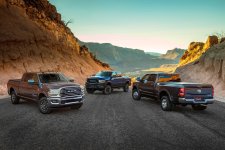
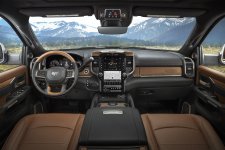
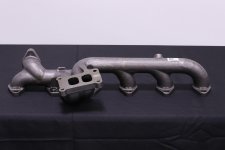

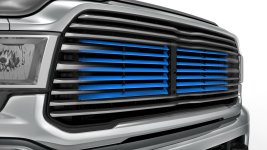

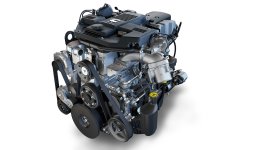
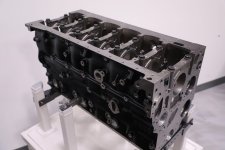
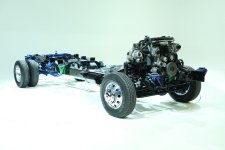
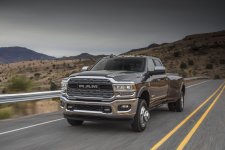
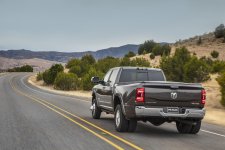
[raw]</div>[/raw]
G.R. Whale
Ram and Cummins have skipped the nickel-and-diming for the 2019 ratings war, going straight to 1,000 pound-feet and a top tow rating in excess of 35,000 pounds. There’s plenty of other stuff too, but you’re going to hear those numbers a lot.
The new 6.7-liter Cummins is built on a CGI (compacted graphite iron) block—lighter, stronger, quieter and proven. Bore and stroke are 4.21x4.88, the compression ratio on the standard output is 19.0:1 while the HO is 16.2:1 and virtually everything else is different: rotating parts, pistons, head with improved exhaust braking performance, injectors, high-pressure pump, entire air-handling system, turbo…and the display wasn’t marked but it sure looked like an EGR cooler top right side. There’s more aluminum where it makes sense—water pump housings, brackets, etc.—and it runs on a dual-core processor.
Standard output is 370 horsepower (at 2800 revs) and 850 lb-ft (@1700), the HO engine is 400 and 1,000 respectively (peak torque occurs 100 rpm higher than the SO engine), and Chassis Cab trucks will get the updated engine so expect an increase when that appears in Chicago next month. Those are the only ratings…there’s no manual gearbox rating because no manual is offered. Ram noted with an ever-declining percentage (less than 4% recently) and fiscal responsibility said don’t spend developing a new manual gearbox, though I’m sure Cummins has the ability to deliver a “de-rated” engine package that could match the current manual gearbox capacity.
Both the 68RFE and AS69RC have been lightly upgraded, much work around engine integration with the dual-core processor aimed at better drivability. Both these transmissions are diesel-only and run by column shifter; all gasoline HD trucks run the 6.4-liter and a ZF eight-speed automatic with the rotary shifter. Power Wagon still has a transfer-case lever on the floor, and the eight-speed gives it a crawl ratio of 50:1.
The Max Tow package returns and brings with it larger rear rotors, a 12-inch ring gear, bigger bearings and shafts, the latter requiring a larger bolt circle, so whether or not you get Max Tow every dually will have a different bolt pattern than SRW trucks. With Cummins power, only the MegaCab 4x4 2500 has a tow rating of less than eight tons.
Of course cooling is upgraded too, the radiator taller, 39 inches wide and the grille opening 30% larger. Despite the added cooling aero drag has dropped by eight percent, in big part from the airdam and active grille shutters (all engines).
Everything else underneath will look familiar but not identical. The new rails are fully boxed, crossmembers stouter, 63 ksi steel used for the gooseneck mount, axles and brake calipers larger, springs a bit further outboard, shocks are monotube frequency selective dampers (except Power Wagon’s Bilsteins) hydro C-pillar body mounts and active mass dampers from the 1500, exhaust hangars different, the basic claims being stronger, quieter, and more refined. If I didn’t hear “capability” once a minute I didn’t hear it at all.
Though it’s all been massaged suspension configurations parallel the current truck, with the full-air 2500 and auxiliary-air 3500 options.
Last year’s bed and cab structures get a new tailgate, bumpers, front clip and mirrors, but the mirror mounts remain the same. There are at least four styles of lights and grilles, at least seven new wheel designs and a factory bed step option. Those mirrors now offer cameras (for the aerial 360 image), LED rear facing spotlights and power convex sections on the towing units—linked to the driver memory system if you get it.
Those bodywork changes plus active grille shutters on every powertrain yield a claimed 8% aero improvement, with the bumper/airdam area getting credit for almost half that: the coefficient of drag on a 2WD Quad Cab short bed is 0.409, and, thanks to an aluminum hood, revised bumpers and some other changes the truck is 143 pounds lighter: A co-pilot without exceeding GVWR.
Inside, the cabin is virtually lifted from the 2019 1500 model, including the real leather, wood and metal trims, a unique key fob for Limited trim, and the 12-inch tablet screen to echo a pair of stacked 8.4s. The Ram comes with active noise cancellation on all drivelines and is said to be 10 dB quieter than the old one, all the better for sampling the 17-speaker, 750-watt optional Harman/Kardon sound system. Headrests are now four-way adjustable—though I missed checking the center rear, multiple type-C USB ports allow charging at least three phones at once, Uconnect supports Waze and Google maps, the Power Wagon has a forward camera for trail use, there’s trailering reverse guidance, a trailer-mount backup camera with independent 12-way connector and tire-pressure monitoring for up to 12 tires on four different trailers.
Ram attributed the early availability of uncamouflaged tester photos to three items: One, it helps build awareness and interest. Two, it saves thousands of dollars on camo. Three, it lead to more than one-million miles of real-world testing and loads. They also pointed out that Ram 3500 has the highest rated resale value, while an article I read en route names Ram 3500 reliability “well below average.” Damn statistics.
Expect 2019 HD Rams to roll into dealerships in April or May so you can find out yourself.











[raw]</div>[/raw]

 Attention: TDR Forum Junkies
Attention: TDR Forum Junkies 






